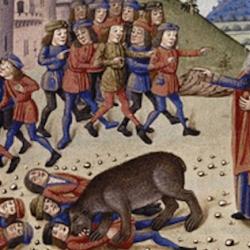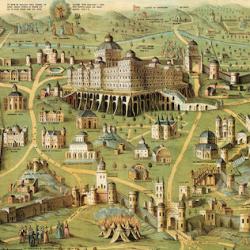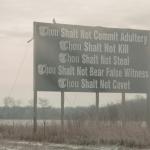INTRODUCTION
Jeroboam?s dynasty has come and gone, and so has Baasha?s mirror-image dynasty. Omri initiates a new dynasty, and this is the most successful one in Israel?s history. It is also the most idolatrous one.
THE TEXT
?In the twenty-seventh year of Asa king of Judah, Zimri had reigned in Tirzah seven days. And the people were encamped against Gibbethon, which belonged to the Philistines. Now the people who were encamped heart it said, ?Zimri has conspired and has killed the king.?E . . . ?E(1 Kings 16:15-34).
STRUCTURE
The account of Omri begins a lengthy section (1 Kings 16-2 Kings 10) of Kings that focuses on the prophetic ministry of Elijah and Elisha. The whole section is arranged in a fairly neat chiasm:
A. Worship and Destruction of Baals (1 Ki. 16-18).
B. Queen Jezebel kills prophets, threatens Elijah; Elisha called (1 Ki. 19).
C. Ahab has Ben-Hadad ride with him, after battle (1 Ki. 20).
D. Naboth’s vineyard (1 Ki. 21)
E. Jehoshaphat and Ahab, 1 Ki. 22:1-50.
F. The reign of Ahaziah, 1 Ki. 22:51?E Ki. 1:1.
G. Sick king condemned by prophet, 2 Ki. 1:2-18.
H. Exodus and Return of Elisha, 2 Ki. 2.
I. War with Moab, 3:1-27
J. Elisha provides for indebted widow, 4:1-7
K. Elisha raises the Shunammite’s son, 4:8-37
L. Elisha heals the poison stew, 4:38-41
L?E Elisha feeds 100 men, 4:42-44
K?E Elisha heals Naaman the leper, 5:1-27
J?E Elisha recovers a borrowed axe head, 6:1-7
I?E War with Syria, 6:8?E:20
H?E Exodus and Return of Shunammite, 2 Ki. 8:1-8.
G?E Sick king “saved” by prophet, 2 Ki. 8:9-15.
F?E The reign of Jehoram, 2 Ki. 8:16-24.
E?E Ahaziah and Joram, 2 Ki. 8:25-29.
D?E Vengeance for Naboth’s vineyard (2 Ki. 9, esp. vv.25-26)
C?E Jehu has Jonadab ride with him, during battle (2 Ki. 10).
B?E Queen Athaliah kills princes, threatens Joash; Joash becomes king (2 Ki. 11:1-12).
A?E Destruction of Baals (2 Ki. 11:12-20).
COUNTERFEIT DAVID
Some months ago, when we began our studies in Kings, we looked at the reign of Omri, and discovered that his life ran in parallel to David?s life. Like David, he was an army commander who fought Philistines (1 Kings 16:15). Like David, he succeeded a suicidal king (1 Kings 16:18; 1 Samuel 31). Like David, he became king only after a civil war (1 Kings 16:21; 2 Samuel 3). Like David, he divided his reign between two capitals (1 Kings 16:23-24; 2 Samuel 5:5). He bought the hill of Shemer for his capital, just as David purchased the threshing floor of Araunah as the site for the temple (1 Kings 16:24; 2 Samuel 24). Unlike David, he does not walk in the ways of Yahweh but worships idols (1 Kings 16:26).
Several themes dominate the account of the Omride dynasty. First, Omri and his son Ahab evidently pursue a program of ?re-Canaanitization,?Ereinstituting the worship and practices of the Canaanites whom Yahweh drove from the land (1 Kings 16:31-32). By intermarrying with the house of David, they also evidently want to reunite the kingdom under an Omride king. As we shall see, they almost succeed. Second, because the Omrides are like Canaanites, there needs to be a new exodus and a ?re-conquest?Eof the land. The ministries of Elijah and Elisha develop these themes. Third, there is a ?provocation to jealousy?Etheme (16:33). In Deuteronomy 32, Moses warned the people that if they provoked Yahweh to jealousy by going after other gods, He will provoke them to jealousy by paying attention to other peoples. Elijah and Elisha spend a lot of their time ministering among Gentiles, which is supposed to provoke Israel to jealousy and repentance.
COUNTERFEIT SOLOMON
If Omri is a counterfeit David, Ahab his son his a counterfeit Solomon. Like Solomon, he marries a foreign woman, Jezebel, who is also an idolatrous woman (16:31). It is significant that Jezebel comes from Sidon, the twin city of Tyre. Solomon made an alliance with Hiram of Tyre to build the temple, and Ahab enters a marriage alliance with Sidon. Like Solomon, Ahab is a temple builder (16:32); unfortunately, it is a temple for Baal not Yahweh.
The names of the Sidonians are intriguing. The name ?Jezebel?Eplays on the word zebul , which is sometimes included in the name of Baal (2 Kings 1:3, 6). Jerome Walsh says that ?The word zbl , ?Prince,?Ewas probably pronounced zabul or zebul , as in the name Baalzebul or Beelzebul, ?Baal is Prince?E(which itself is usually deformed in the Bible to Baalzebub or Beelzebub, ?Baal of Flies?E. Pronounced zebel , the element resembles a word in other Semitic languages for ?excrement?Ethat may well have existed also in Hebrew, though it is not attested in the Hebrew Bible.?EJezebel is both a daughter of Baal, and dung. Her father?s name includes the name of Baal explicitly, and his name is the first reference in Kings to Baal. It is not the last; Baal worship is beginning to take over the Northern kingdom. It is the latest craze. (According to Josephus, Ethbaal (Ittobal) was the grandfather of Dido of Carthage, famous in the Aeneid [ Against Apion , 1.18].)
Verse 34 speaks of another building project, the rebuilding of Jericho. It is likely that Ahab authorized this building, since a project to rebuild a border city would not likely be done without the king?s permission. Of course, Jericho was the first city conquered during the conquest, and the rebuilding means that the conquest is being reversed. Instead of destroying Canaanites, Ahab is rebuilding their cities. It is not clear whether Hiel the Bethelite killed his sons or if they died from natural causes. In the ancient world, ?foundation sacrifices,?Ehuman sacrifices to consecrate the building of a city or temple, were not unknown (Cain/Abel; Romulus/Remus). Though Hiel and Ahab are sinning when they rebuild Jericho, they in fact participate in the fulfillment of the word of Yahweh, the word of curse spoken centuries before by Joshua (Joshua 6:26).















